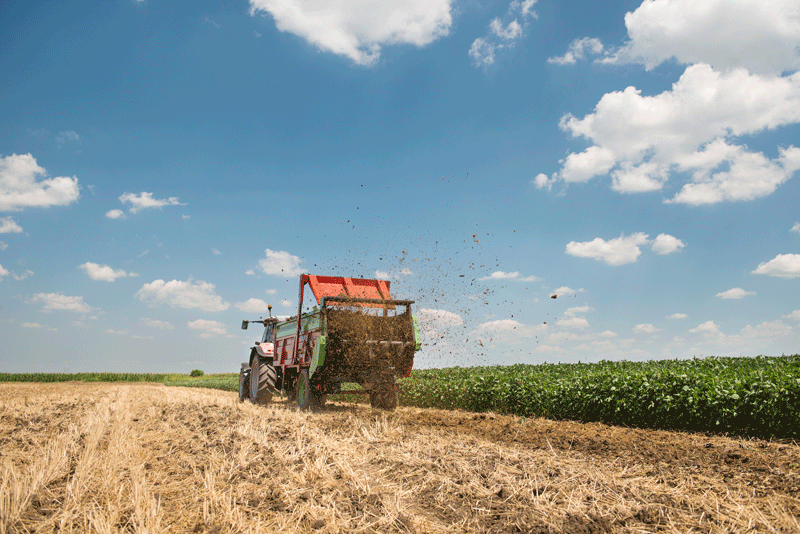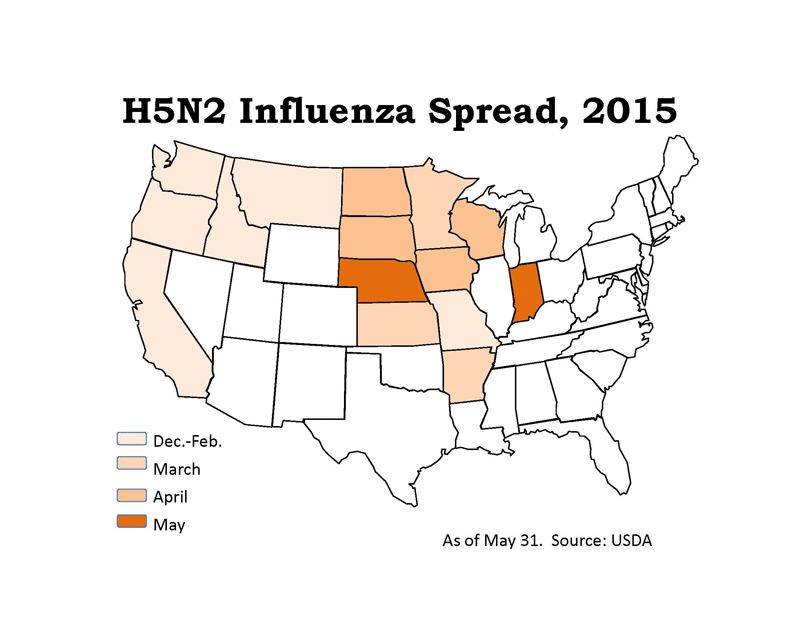Disease risk prevention from the field
ANIMAL BIOSECURITY MEASURES IMPACT GRAIN FARMERS
THE INCREASING SPREAD of infectious on-farm diseases means biosecurity has never been more essential. Biosecurity has become an important management focus on livestock and poultry farms, and the potential spread of diseases from fields, soil, and farm equipment can’t be overlooked as part of a complete biosecurity plan.

“Farmers are more sensitive to disease spread and tend to increase biosecurity practices when we’re under a threat or quarantine,” says Christine Brown, field crops nutrient management lead with the Ontario Ministry of Agriculture, Food and Rural Affairs (OMAFRA). “But we can’t forget that prevention protocols are always important.”
Most Ontario livestock and poultry farmers already have strict biosecurity protocols in place, but grain farmers and custom field equipment operators can’t overlook their role in disease prevention and the importance of field and farm equipment in biosecurity practices.
“There was a time when custom work operators, agronomists, and field scouts were concerned about the spread of soybean cyst nematode from field to field and we were stringent about cleaning soil off our boots,” says Brown, noting the threat of spreading diseases from fields has increased to highly infectious livestock and poultry diseases that can be carried in manure residue from fields. “Infectious diseases have a huge impact on our neighbouring farmers and we need to return to those precautionary measures when travelling from field to field or between farms.”
CONTAMINATED FIELDS
Recent Avian Influenza and PEDv outbreaks in Ontario serve as a reminder that everyone plays an important role in reducing the spread of infectious diseases. The Feather Board Command Centre (FBCC) and OMAFRA sent out advisories to poultry farmers and issued a number of best management practices (BMPs) during the spring 2015 outbreak of Avian Influenza because wild migratory birds are known to spread the disease. The virus is carried in bird feces and respiratory secretions and can be spread from fields where they land to eat and rest via humans, contaminated equipment and animals like cats, dogs, and rodents. Southern Ontario is part of a migratory bird path in spring and fall, making the spread of disease from flocks of birds resting in fields a serious risk.
During the Avian Influenza outbreak, the FBCC reminded poultry farmers that field cultivation and planting equipment covers every inch of fields that could be contaminated by wild birds. “The spread of pathogens between poultry farms mainly results from the movement of infected birds, contaminated clothes, footwear, farm equipment, or vehicles,” says Dr. Csaba Varga, OMAFRA lead veterinarian, Disease Prevention – Poultry. “Vehicles and farm equipment must be clean and free from manure and, where available, use designated farm equipment or designated property wash down facilities. Varga also reminds farmers to ensure all people entering or leaving the farm have clean clothing and footwear, free from soil and manure.
FIELDWORK TIPS TO FOLLOW
“Precautionary measures will be different for each farm,” says Brown. “Each species faces its own disease risks and farmers need to be proactive about understanding the pathogen/disease cycle and making their risks and prevention protocols known to farm visitors, including veterinarians, consultants, agronomists, and custom operators.”
Brown reminds Ontario farmers it’s everyone’s responsibility to do as much as they can to reduce the threat and spread of pathogens or diseases by making biosecurity measures part of their everyday routine.
“It takes a common sense approach of knowing where you are and where you’ve been,” reminds Brown, noting fall fieldwork such as tillage, manure application, and soil sampling all increase the risk of spreading highly infectious diseases. “Everyone is responsible for doing their part to reduce the spread of diseases from organic matter, like manure, in fields to livestock or poultry farms.”
Brown says all farmers, especially custom work operators, those applying manure, and those traveling from fields to barns should follow these recommended BMPs.
- Schedule farm visits — where possible, schedule appointments with highest risk farms last
- Pay attention to footwear and clothing when traveling between farms and fields — consider keeping a change of clothes and boots in the tractor or truck, just in case.
- Clean your footwear — remove obvious mud and organic matter first and scrub boots, paying close attention to bottom treads, with a brush and hose; consider using disinfectants
- Wash vehicles and farm equipment between farms and fields and pay close attention to the vehicle’s tires — this is essential during periods of heightened biosecurity
- Drive slowly — especially near barns to minimize dust and the creation of air-borne particles
- Be careful where you park — avoid parking trucks or equipment near barn exhaust fans or air inlets
- Track your travels — keep your own records identifying when and where you’ve been
- Do not enter any farm buildings unless authorized — obtain permission from the farmer or farm manager before entering any barns or buildings
AMERICAN AVIAN FLU CASES SLOW
Edith Munro
Since mid-December 2014, the outbreak of H5N2 avian flu has spread to 15 U.S. states. More than 48 million birds on 223 farms have died or been euthanized in efforts to halt the disease’s spread. Additional outbreaks were reported into June, but the frequency of cases slowed and remained concentrated in the upper Midwest.

Egg production has been the hardest hit and the price of eggs has more than doubled in U.S. supermarkets. Broiler prices, however, have fallen as some 30 nations have restricted or banned U.S. poultry shipments, making more product available in the U.S. domestic market.
So far, there is no evidence of the disease spreading into the big broiler-producing states of the southeast (Georgia, Alabama, Arkansas, North Carolina, and Mississippi) which consume more feed than the layer and turkey industries. How bird losses will affect feed demand for corn and soy meal long-term is uncertain. At the end of May, Rich Nelson, chief strategist for Allendale, Inc., put lost corn demand at 30 to 35 million bushels, or less than three per cent of the 1.24 billion bushels that normally go into U.S. poultry production. For soybean meal, the toll is estimated at 710,000 tons. However, local corn and soybean meal prices have weakened in areas most affected by the outbreak. In Iowa, for example, affected farms have not only halted feed purchases, in a number of cases big poultry operations are selling their stocks of corn, potentially lowering local prices by six per cent or more.
Once the outbreak has definitively ended, it is likely to take a year and a half to two years for affected farms to return to full production, according to Steve Olson, executive director for the Minnesota Turkey Growers Association and the Chicken and Egg Association of Minnesota. •






















